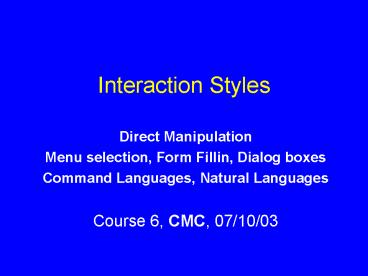Interaction Styles - PowerPoint PPT Presentation
1 / 25
Title:
Interaction Styles
Description:
Course 6, CMC, 07/10/03. 07/10/03. HC6. 2. Toward an Interaction Style. High concept definition ... Choice of interaction style. easy to learn, to apply, to ... – PowerPoint PPT presentation
Number of Views:62
Avg rating:3.0/5.0
Title: Interaction Styles
1
Interaction Styles
- Direct Manipulation
- Menu selection, Form Fillin, Dialog boxes
- Command Languages, Natural Languages
- Course 6, CMC, 07/10/03
2
Toward an Interaction Style
- High concept definition
- functionality
- goals
- benefits
- Task analysis
- users and tasks
- Choice of interaction style
- easy to learn, to apply, to retain over time
- relevant to users task
3
OAI model
4
Direct Manipulation 3 integrated principles
- Continuous representation of objects and actions
of interest with meaningful visual metaphors - Physical actions or presses of labeled buttons
instead of complex syntax - Rapid incremental reversible operations whose
effect on objects of interest is visible
immediately
5
Visual Thinking and Icons
- Commercial graphic designers, semiotically
oriented academics, data-visualization gurus - Preferences vary by user and by task
- Icons or Text?
- How to design icons?
- Sound and Animation added?
6
Problems with Direct Manipulation
- Visual representations too large for screen, too
detailed - Visual representations without obvious meaning
- Misleading metaphors
- Shift hardware devices
7
Menu Selection
- Effective recognition
- Early systems (selection via keyboard)
- full screen menus numbered, textual
- Modern systems (selection by mouse clicks)
- pull-down and pop-up menus
- radio buttons and check boxes
- embedded links
- menu items textual, graphic, auditory
8
Organization Menu Items
- Meaningful Superiority categorical menu
organization over alphabetical organization - Menu structures single menus linear sequence of
menus strict tree structures acyclic networks
cyclic networks - Key to menu structure task-related objects and
actions
9
Single Menus
- binary menus
- multiple-item menus
- multiple-selection menus (check boxes)
- pull-down and pop-up menus
- scrolling and two-dimensional menus
- alphasliders
- embedded links
- iconic menus, toolbars, palettes
10
Alphaslider
11
(No Transcript)
12
Embedded Links (example)Glosser
13
Tree Structures
14
Pull-down menu (example)
15
Pie menu (example)
16
Tree-Structured Menus Problems
- overlapping categories
- extraneous items
- conflicting classifications
- unfamiliar jargon
- generic terms
- too many levels
- users loss of orientation
17
Suggested Rules
- create task-related groups of logically similar
items - form groups that cover all possibilities
- make sure that items ar nonoverlapping
- use familiar terminology, but ensure that items
are distinct from one another - the fewer the levels, the greater the ease of
decision making - add menu map to help users stay oriented
18
Sequence of Item Presentation
- There is a task-related ordering
- chronological
- increasing/decreasing (number, length, volume,
temperature, ) - There is no task-related ordering
- alphabetic
- grouping of related items
- most frequently used first
- most important first
19
Response Time Display Rate
- Long response times
- Slow display rates
- Use command language
- Greater memory demands
- Short response times
- Rapid display rates
- Use menu selection
- Cues to elicit recognition
20
Form Fillin
- Many fields of data are necessary
- Some guidelines from practitioners
- meaningful title
- comprehensible instructions
- logical grouping and sequencing of fields
- familiar field labels
- error prevention, correction, messages
- completion signal
- List- and Combo Boxes, Coded Fields
21
Dialog Boxes
- Combine Menu Selection and Form Fillin
- Additional concerns
- consistency across all system dialog boxes
- relationships with other items on screen
- Guidelines for internal layout and external
relationships
22
Dialog Box (example)
23
Command Languages
- Strategies for command syntax
- simple command set
- command argument(s) DELETE FILEA
- command option(s) argument(s)
- PRINT/3, HQ FILEA
- A0821DCALGA0300P
- hierarchical command structure
- CREATE FILEA LOCPR1
- DISPLAY DIR1 SCR2
24
Command Languages
- meaningful structure
- consistent argument ordering
- keywords vs. Symbols
- change all KO to OK vs. RS /KO/, /OK/
- congruent hierarchical forms of commands
- move robot forward vs. advance vs. go
- move robot backward vs. retreat vs. Back
- naming and abbreviations
25
Natural Language in Computing
- Natural-language interaction
- restricted to specific tasks
- \erase worksheet \insert row \total all columns
- annoying cursor movements from object to toolbar
- automatic speech for selecting painting tools
- Natural-language Queries
- Text-database Searching

